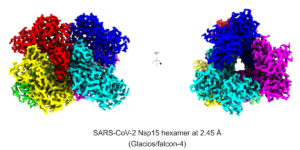
Illustration by Shutianyi Li
This fall, following the National Academy of Engineering (NAE) Call to Action for engineers to “crowdsource and collectively brainstorm engineering solutions for the coronavirus disease (COVID-19),” the USC Viterbi School of Engineering is offering “Viterbi vs. Pandemics!” — a new lecture series by USC Viterbi faculty to comprehensively provide an engineering-centric framework for addressing and understanding the COVID-19 pandemic.
During the 11-week, free program, students gain exposure to myriad topics, ranging from the estimation of risk and protein engineering by directed evolution to the contributions made by computer science and electrical engineering faculty in automating human safety technologies, detecting misinformation and digital contact tracing. The one- to two-hour sessions take place on Thursdays at 6 p.m.
On Thursday, November 12, 2020, Richard Roberts, a professor of chemistry, chemical engineering and materials science, molecular biology, and biomedical engineering and a member of the Norris cancer center, presented his lecture titled “Protein Engineering by Directed Evolution, As Related To COVID-19.”

Professor Richard Roberts is a pioneer in methods for molecular recognition of nucleic acids and proteins. Photo courtesy of Richard Roberts
Roberts’ laboratory uses a directed evolution technology he invented, termed mRNA display, to design new peptides and proteins to study biology and improve human health. Their passion is using the tools of chemistry to understand and control biological processes. They are taking years of research and discoveries into the frontlines of the battle against COVID-19, helping scientists develop new diagnostic tools and therapies.
For those who missed it, can you briefly summarize your lecture for a general audience?
My lecture covered how one thinks about developing therapeutics and diagnostics for viruses generally, and COVID-19 specifically. We did an overview of the basic information we need on the virus to get started with a therapeutic or diagnostic program and talked about technologies used to develop the new molecular tools that the community uses. I also covered the discovery platform that I invented (mRNA display) and presented some of the work my lab has done on SARS-CoV and SARS-CoV2.
First, one needs as detailed an understanding of the virus life cycle as you can get: the components in the virus (proteins, nucleic acids, membranes), how the virus finds a target cell (e.g., cell surface receptors), how the virus gains entry, how the virus propagates (makes protein and replicates it’s genome) and how the virus escapes the cell. Each of these steps generally provides an opportunity for intervention or detection.
Why is this research important? How will it help in the fight against COVID?
We’re focused on therapies and diagnostics for the virus. These are important for determining who is infected with COVID-19 in a definitive fashion (COVID-19 vs. flu vs. other), for following the course of therapy, and for providing actual therapeutic interventions for the virus.
How would you compare your research to similar research or ideas, either in academia or industry?
Industry and academia are primarily focused on developing and using antibodies as COVID-19 diagnostics and therapies. My lab focuses on developing peptides and small antibody mimetic proteins for the same purposes. We are also interested in targeting structural proteins (spike and nucleocapsid) with our peptides and proteins.
What are the next steps and/or milestones in terms of your work?
My academic lab is pursuing two goals: 1) first, we are adapting parts of the receptor/spike complex to develop ACE2 peptides that inhibit viral entry. That work is supported by the Ming Hsieh Institute. Second, we are adapting the SARS inhibitor proteins we developed targeting SARS-CoV for SARS-CoV2.
The Center for Peptide and Protein Engineering is currently working to express reference reagents for COVID-19 – virus spike protein, virus nucleocapsid protein, ACE2 receptor, as well as some known ligands for these proteins. These research reagents should be available to the USC community at the start of 2021.
Tell us about your collaborators. Are you partnering with any doctors, clinicians or other non-engineers in this work?
We are working with labs at Keck, UCLA, and Caltech who specialize in cell-based work to test the diagnostics and therapeutics we are developing.
Can you share one story from your pandemic life? How has it impacted your work and family? What are you doing to stay sane?
Staying at home has reminded me of my interests in gardening and woodworking. I’ve built several projects during the pandemic and had my kids help as well. I stay sane by cooking and riding my Airdyne stationary bicycle.
From a research perspective, what do you consider the most surprising or counter intuitive aspect of the virus or the pandemic as a whole?
At a molecular level, COVID-19 is not that different from the viruses that cause the common cold. The pathology of the two viruses is very different – one ruins lungs, causes cytokine storm, and death, the other a little fever, a runny nose and a cough. The idea that very modest changes can so dramatically alter how a virus behaves is both surprising and foreboding. I hope this experience reminds us that this will not be the last time this happens.
What are some words of wisdom regarding the pandemic that have meant a lot to you?
COVID-19 is a global problem that affects all people. Importantly, in our hour of need, most of the world realizes that science, engineering and medicine provide a light in the darkness and a path forward. All of us “nerds” who practice these disciplines every day hold this passion in our hearts. I think one outcome of these efforts is for the public to better realize the potential of technology and science and to begin to think bigger about addressing other serious problems like climate change.
If you could only share one slide from your talk, what would it be and why?
A general one on how the virus replicates. Viruses are like machines. Detecting them and defeating them just requires that you understand which part to target for the intended effect.
Published on November 19th, 2020
Last updated on November 19th, 2020












